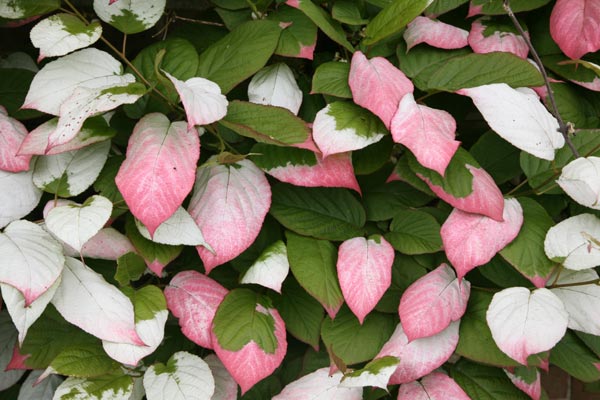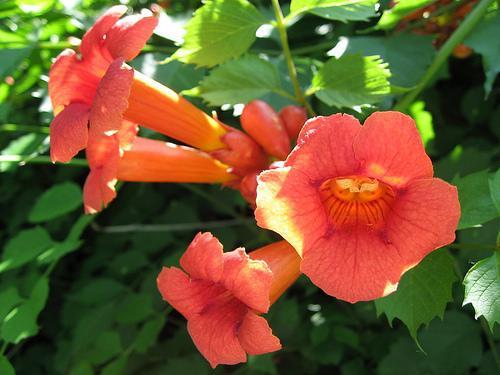Here’s a quick look at six of the best vines to plant in your garden this spring. These will get visitors to look up. Raising their head will give them a positive feeling and you’ll also be giving them something beautiful to look up at.
This list, of course, is just a start. There are many other vines worth considering. But this is a good start to be going on with.

Kiwi vine
The heart-shaped leaves of Actinidia kolomikta are what make it so magical. In full sun the tips turn a strawberry pink or creamy white. Once the vine is well-established, the decorative effect of the variegated colour can be striking.
Actinidia is a popular, useful, handsome climber and a lot more graceful and easy to accommodate in the average-sized home garden than its rampant cousin, A. chinensis, the Chinese gooseberry.
That species is so vigorous it will clamber 30 feet (9 m) into a large tree or smother the wall of a house. Don’t bring home the wrong plant.
As well as the interesting leaf coloruing, the kolomikta vine produces mildly fragrant, cup-shaped white flowers in June. Size: 10 to 14 feet (3 to 4 m).

Chocolate vine.
Akebia quinata, the chocolate vine, has two endearing qualities – superbly graceful five-lobed leaves, which are a delicate shade of green, and mildly vanilla-scented chocolate-coloured flowers in spring.
The worst thing anyone is going to tell you about this vine is that it is too vigorous. How vigorous? In ideal conditions, it can travel 30 feet (9 m), although it may take its time to get started on that journey. The pluses far outweigh the minuses.
Its ambitious ways can be controlled and the purple flowers, whose fragrance some have compared to expensive French soap, more than compensate for any over-enthusiasm. Size: 20 to 26 feet (6 to 8 m)

Trumpet vine
The trumpet vine produces rich, deep-throated, red flowers that have an extremely sensual, pouty, lipstick look to them. That’s why hummingbirds can’t stay away. But love will not make this vine flower.
Only hot sun will do it. Campsis x tagliabuana ‘Madame Galen’ is a hybrid, resulting from crossing the Chinese trumpet creeper (Campsis grandiflora) with the common trumpet vine (C. radicans).
Vigorous and hardy in most coastal gardens, ‘Madame Galen’ has salmon-red flowers, is more winter-hardy than both parents, and is easily capable of clambering at least 15 feet high (4.5 m) and 3 or 4 feet (90 to 120 cm) wide in the right spot. You can grow it into trees or use it to cover sheds or old tree trunks.
All it needs is a simple trellis or post for support to get started. It climbs stealthily, without a lot of wasted effort, clinging as it goes to whatever it can use to attach its tiny aerial roots.
If exposed to too much frost, it will die back to the ground, but, being a born survivor, it invariably rallies the following year.

Clematis
The most sociable of climbers, clematis is deservedly called the “Queen of Vines”. No garden should be without at least two or three. Some gardeners have planted as many as half a dozen at a time to cover a single trellis or arbor. Choosing the right clematis is the key to success. The selection can be overwhelming.
FOR MORE INFORMATION.
In commercial cultivation at the moment there are at least 50 blue-flowering clematis, 34 pinks, 30 purples, 16 two-tones, 34 whites, 21 reds and 10 yellows. Once you’ve chosen the colour you like, the next step is to decide what time of year you want it to flower. You can get clematis that blooms in early spring or summer or fall.
Always popular and very dependable for coastal gardens is Clematis x ‘Jackmanii’, arguably the most reliable performer of the summer-flowering cultivars. Producing masses of 4- to 6-inch (10- to 15-cm) purple flowers from June to August.
There is also ‘Jackmanii Superba’, which has fuller flowers, and ‘Jackmanii Alba’, which has double pale bluish-purple flowers.

Jasmine
The garden at the peak of summer is so full of wonderful flower colour and fragrance it is easy to become blasé about nature’s abundance and generosity. Not surprisingly, poets through the ages have paused to reflect on this extraordinary exuberance while breathing in the exquisite fragrance of pure white jasmine (Jasminum officinale).
This twining climber can be kept pruned to under 10 feet (3 m) or it can be allowed to sprawl over an arbor or fence. Jasminum nudiflorum (winter jasmine) is also popular with gardeners because it produces bright yellow blooms in winter when the garden is bereft of colour. It can grow to 6 to 12 feet (1.8 to 4 m).

Passion vine
Everyone who sees the extraordinary flowers of a blue passion vine immediately falls in love with them.
They are quite unique. Each flower has 10 petals, which provide a decorative backdrop for a skirt, or fringe, of purple-blue bristles. Above the bristles, there are five green stamens with three more purple-coloured stamens above them. The whole complex construction is superb.
All of which makes the vine a fascinating conversation piece for the garden as well as an outstanding plant with gloriously glossy foliage. Flowers first appear in July.
They do not crop up in exuberant flushes, but singularly and sporadically, here and there, usually not more than half a dozen on the vine at any given moment throughout the summer. Exotic-looking, they measure 3 inches (7.5 cm) across and can be cut and floated in water in a rose bowl indoors.
The vine also has fabulous, glossy green foliage, which in mild areas will stay green all winter. At the end of summer, flowers give way to yellow passion fruits. They are not edible. Native to Brazil and Argentina, it is vigorous and can easily cover a large wall 15 by 20 feet (4.5 by 6 m).
swhysall@hotmail.com

















Not a fan of Ampelopsis, Steve?
Comments are closed.